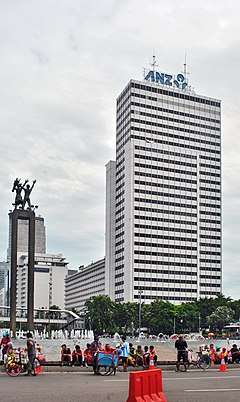Wisma Nusantara
| Wisma Nusantara | |
|---|---|
 Wisma Nusantara and the adjacent Hotel Pullman. | |
| General information | |
| Status | Complete |
| Type | Office |
| Architectural style | International style |
| Location | Jakarta, Indonesia |
| Address | Jl. M.H. Thamrin No. 59, Jakarta 10350 |
| Coordinates | 6°11′38″S 106°49′25″E / 6.193962°S 106.823673°E |
| Construction started | 1964 |
| Inaugurated | December 2, 1972 |
| Owner | Pt. Wisma Nusantara International |
| Height | 117 m (384 ft) |
| Technical details | |
| Floor count | 30[1] |
| Floor area | 25,386 m2 (273,250 sq ft)[1] |
| Lifts/elevators | 4 units for 13th-28th floor, 3 units for 1st-13th floor[1] |
| Design and construction | |
| Main contractor | Mitsui Construction Co. |
Wisma Nusantara is an office highrise building located in Jalan M.H. Thamrin, Jakarta, Indonesia. Constructed in 1964, Wisma Nusantara is considered to be the first highrise in Indonesia and Southeast Asia[2] to reach 100 metre height. The building complex included the Pullman Hotel.
History
The construction of Wisma Nusantara was inspired by President Soekarno's intention to have the first high rise building in Jakarta. The first contract was awarded in 1964 for $5.7 million[3] using the Japanese war reparation and construction commenced in the same year. However, the decline of the rupiah and the attempted coup d'etat interrupted the construction of Wisma Nusantara. As a result the money ran out, leaving the building unfinished with only its steel frame completed for more than 5 years.[3][4]
Construction work was continued by Mitsui Construction Co. in 1972 after the renewal of the contract. Wiratman Wangsadinata, the founder of PT. Wiratman & Associates, was chosen as the supervisor of the project in 1970. The building was finally completed in 1972. It was officially inaugurated by President Suharto on December 2, 1972, together with the adjacent President Hotel (now Pullman Hotel).[2] As part of the deal, the share was held by Mitsui 55% and the Indonesian Government 45%.[2] Because of the considerably high cost of renting office space, the building was only used by Japanese companies for a couple of years. Because of this, the building stimulated the antipathy of Indonesian citizens.[3] The building was at one time topped with a large sign of Suzuki. An Indonesian movie directed by Sjumandjaja Budak Nafsu (1984), literally "slave to lust", depicts a scene where a young woman was raped and made a concubine for the Japanese during the war, and having lost her energy for life, wanders around Jakarta surrounded by neon signs of Japanese enterprises on Jalan M.H. Thamrin, which clearly shows sentiment toward the Japanese in Indonesia during the period.[3]
The first major renovation was done in 1990 which consist of JICA building construction. The connecting bridge between Wisma Nusantara office building and the hotel (then known as Nikko Hotel) was built in 2002. In 2003, Nikko Hotel was expanded with an additional 11-story executive suite tower to the north of the Wisma Nusantara complex. This hotel tower was designed by Kenzo Tange International. In 2005, the Annex Building was completed to accommodate parking.
Design
Wisma Nusantara is considered to be the first skyscraper in Indonesia and Southeast Asia to reach the height of more than a hundred meters. It was the first earthquake-proof building prototype of the second generation of highrises in Japan. Japan-imported high-quality steel was used as the main structure for the office building. Wisma Nusantara used caisson foundation to stabilize building when an earthquake happens.[2]
References
- 1 2 3 "Wisma Nusantara - Building Information - Facilities". Wisma Nusantara. Pt. Wisma Nusantara International. 2014. Archived from the original on June 16, 2016. Retrieved June 16, 2016.
- 1 2 3 4 "Wisma Nusantara - history". Wisma Nusantara. Pt. Wisma Nusantara International. 2014. Retrieved June 15, 2016.
- 1 2 3 4 Miyake 2006, p. 6.
- ↑ Merrillees 2015, p. 105.
Cited works
- Merrillees, Scott (2015). Jakarta: Portraits of a Capital 1950-1980. Jakarta: Equinox Publishing. ISBN 9786028397308.
- Miyake, Yoshimi (2006). "Political and cultural aspects of Japanese war compensation to Indonesia" (PDF). Meiji Gakuin Daigaku Gengo Bunka Kenkyu 23. Retrieved June 15, 2016.